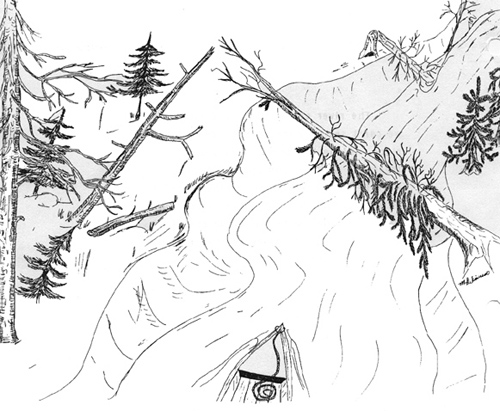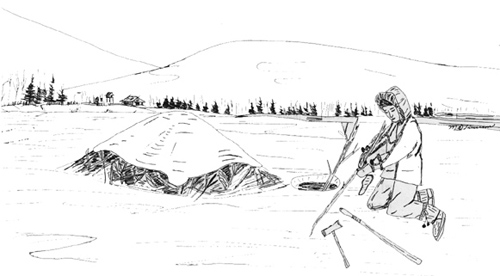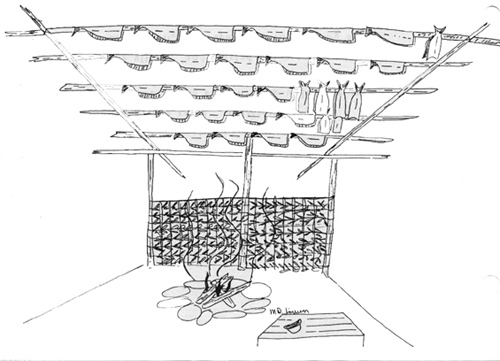TETLIN AS I KNEW
IT
Written by
Shirley David Jimerson
Edited by
Patricia Partnow
Illustrated by
Michael Jimerson
1975
A Production of the
Alaska Bilingual Education Center
Of the Alaska Native Education Board
4510 International Airport Road
Anchorage, Alaska
Copyright 1975 Alaska Native
Education Board
6-75-500
Table of
Contents
Chapter I------A trip
around Tetlin
Chapter II-----Getting ready for winter
Chapter III----Wintertime: Beaver Camp
Chapter IV ----Spring and Muskrat Trapping
Chapter V-----Fish camp at Last Tetlin

CHAPTER l
A Trip Around Tetlin
Let's imagine we're looking at the fish
campsite - Last Tetlin. From the riverbank, we can see a tent frame
and a smokehouse for each family. Trails branch out here and there
from the campsite. Fireweed is growing all over.
We walk to the back of the village. From there
we can see all the lakes - there are lots of them - which empty out
into the Last Tetlin River.
We take a boat downriver toward the fish
traps. In the clear spots we can look down to the bottom of the river
and see whitefish and northern pike swimming around.

The river curves, back and forth, so we can't
see very far down it from any one place. Along the banks there are
spruce trees and willows, and once in awhile we have to steer the
boat out of the way of a fallen tree that hangs over the river. As we
go down toward the mouth of the river, we can see that the trees are
getting taller and more dense.

Last Tetlin River empties into Tetlin Lake -
the largest lake in the area. When we enter the lake from the river,
we see the mountains at the far side. They seem to flow into the
lake.
We'll go around the lake clockwise. The first
creek we come to is Bear Creek. It's very clear and ice cold, and
there are lots of fish in it in the summer and fall.
We go on past the creek, along the lake-shore,
until we come to an island. The lake between the Island and the shore
is very shallow and is a favorite place for moose. They feed on the
water lily roots.
All along the west side of the lake, there are
marshy areas like this where moose feed and ducks of all types can be
found.

Tetlin Lake is a major area for molting ducks
in the summer. Canvasbacks, widgeon, pintail, shovelars, greenwing
teal, and some mallards can be found there.
We'll go on to the north side of the lake. The
land becomes more hilly and the shores are rocky. This is one place
where my family fishes.
We'll keep going around the lakeshore. From
the northeast side of the lake we can see a hill we call "Rock Hill".
We pick raspberries on Rock Hill.
We go past Rock Hill, and the banks be-come
high and steep. We can't see much over the bank from our boat until
we come to the mouth of Tetlin River. Then we can see the area
between the mouth of Tetlin River and the mouth of Last Tetlin River;
it's flat and willowy.
(the canaries referred to are yellow
warblers).
Going up the Tetlin River, we can see only the
high banks for quite awhile. Once in awhile we can see bears up on
the banks -brown or black bears. Common snipes skitter along the
riverbanks. Blackbirds chatter. Woodpeckers hammer away somewhere in
the forest. We hear canaries, chickadees, and crows, all singing or
talking. How beautiful it all sounds!
Every now and then a creek empties water out
of some small lake into the Tetlin River. There are lots of willows -
river willows - hanging over the river.
Finally we see Tetlin Village. It sits on the
left bank of the river, and we can see it clearly from the place
where we beach the boat. People come down to meet us - it doesn't
matter if we're strangers. They'll come down to meet us
anyway!
Before we go inside we take a look around. The
land rises from the village toward the north. One of the hills,
called Tetlin Hill, is a good place to find blueberries and
cran-berries. And to the south of the village, the land becomes
marshy. That's where the muskrat and beaver can be found.

From Tetlin Village we can follow a trail
anywhere we want to go - all over our land.
But that's a different journey!

CHAPTER II
GETTING READY FOR WINTER
Fall was the time to get ready for the winter
- the start of another yearly cycle. There was lots to do.
When I was little, the women and children (and
one man, to protect us from bears) used to leave the village and go
up into the hills to pick berries. We picked cranberries,
bearberries, and rose hips. We'd be gone all day, and come back to
the village at night.
We dug roots, too - a kind called Indian
potatoes. They are very good when they're fried in moose
grease.
Indian potatoes were obtained on the crest of
the hill between the river and the village on the winter trail to
Midway Lake. They're also called "Eskimo potatoes", and are the
species Hedysarum alpinum L.
Bears were not systematically hunted by Tetlin
residents. Berries were picked in the hills behind the village.
Blueberries were also picked there. The berry area is to the right in
photograph #2 of Tetlin.
Fall was also the time to do some last minute
fishing. We fished for whitefish and northern pike in the Tetlin
River close to the village, and we went up the Kalukna River for
grayling.
The men - my dad, brother, uncles, and some
other relatives - went hunting at Tetlin Lake. They stayed there
until they shot a moose. Then they cut it up and brought the meat and
hide back to the village.
Sometimes, if someone had a car or truck, the
men drove up the Taylor Highway to Mt. Fairplay to hunt caribou. In
the old days, my dad told me, they hunted caribou down by Last
Tetlin. There used to be a caribou fence there. But when I was
little, the men had to go all the way to Mt. Fairplay.
The meat, both moose meat and caribou meat,
was brought back to the village. There, the women dried it and smoked
it. The children had to keep a smoky fire going in the smokehouse all
the time. Besides smoking the meat, the fire kept the flies out,
too.
The women also tanned the hides. My mom used
tanned hides to make mittens, mukluks, and moccasins. She did
beautiful beadwork on the hides.

If we didn't do all these things -berry
picking, fishing, and hunting - our caches would be empty before the
winter was over. My mom and dad used to tell us that in the old days,
an empty cache meant sure death. So fall was a very important time of
the year for us.
Chapter
III
Wintertime: Beaver Camp
Both beaver meat and muskrat meat are eaten,
dried or cooked.

The trip took about 12 hours from 4a.m. till 4
p.m
In early February my family used to move to a
beaver camp called Sea Lake. We went by dog sled. My dad drove the
first sled packed with all our gear. He went ahead to break trail.
Then my mom followed, driving the second sled. This sled was packed
with us children.
At that time there were three of us: I sat in
the back, my brother Charles sat between my knees, and our baby
sister Betty sat in front of him. We were all wrapped up in sleeping
bags and canvas, and tied in with strong rope. We couldn't move at
all, we were tied so tightly. What a relief it was when Mom and Dad
finally decided it was time for tea break! It never came soon enough
for us.
When we got close to camp, my dad started
setting some of our beaver snares. Then when we got to the campsite,
we pitched the tent and started fixing it up. Dad put the stove in
place while Mom, my brother, and I gathered spruce boughs and spread
them on the tent floor. Dad got the fire going in the stove, Mom
cooked supper, and then we all went to bed early. Tomorrow would be a
busy day - we'd be setting the rest of the snares.

Next day we got up early and ate a quick
breakfast. While Mom was packing lunch for all of us, Dad was
hitching the dogs to the sled. Then the whole family was off to set
snares.
Dad knew where he had set snares the year
before, and he went to those places to check out the old beaver
houses. Some-times beavers had abandoned their old houses and moved
to new ones. But sometimes the old houses were being used again this
year.
When we found a live house, Dad would chisel
an opening in the ice nearby. He cut a pole of fresh birch to use as
bait, and stuck it down into the opening he had made. By now the
beavers were tired of their stored birch, so they welcomed the fresh
pole my dad put down as bait. Then we looked for another pole - a dry
one this time - and put one or two snares on the end of it. We didn't
have to worry about the beavers eating the dry pole. Dad lowered it
down the hole next to the bait pole, kicked some snow over the
opening, and continued on to the next beaver house.

We checked the beaver snares every day. On a
good day we'd come home with a load of beavers. Usually, after the
first day, just Dad and I or Dad and my brother would go along the
trapline, and the other three members of the family would wait back
at camp.
At night, Mom and Dad used to tell stories
about the days when they were growing up. Mom told us stories about
how she and her brother came to Tetlin to live with the chief after
their parents had died. Mom was only about 10 years old. She came
from Chena, and she had to learn a new language when she got to
Tetlin. She was often scared and lonely when she first moved to our
area.

Mom and Dad also remembered when white
teachers and ministers came to the Tetlin area, and how terrifying it
was for them. The people had to give up their old nomadic way of life
and settle down in one place. In order for their children to go to
school, they had to live near the school, and the children had to
learn English. People tried to make a living the new way -men hunted
for jobs, but jobs were scarce. This was a scary time for the people
of Tetlin.
When I think of the stories my parents told us
at beaver camp, I can still smell the fresh spruce boughs on the tent
floor, biscuits, tea, and the firewood in our tent. And I remember
lying in bed listening to the owls talk at night after everyone else
was asleep.

CHAPTER IV
SPRING AND MUSKRAT TRAPPING
Sometime before break-up my family used to
move by dogteam to Dog Lake be-tween Tetlin and Northway for muskrat
trapping. We had a cabin there, so we didn't have to pack many things
- mostly some food and blankets. We joined another family, the
Tituses, who also had a cabin at Dog Lake.
Mom and Dad went out to set the musk-rat traps
while we children stayed around camp. The older children had to look
after the younger ones.
Sometimes we older children would go out on
the lake, find our own muskrat houses, and set traps in them. It's
easy to set traps. Just cut the top off the house and put a trap
inside in the ice entryway. Then put the cover back on the house, and
move on to the next muskrat house. We went back every day to check
the traps. We children used to get from 50 to 100 musk-rats during
one spring at muskrat camp.
Each of us skinned his own muskrats. We
learned how to stretch them and dry them, so we could sell them to
the General Store.
Around break-up time, when the snow became
slushy, we packed up our sleds and headed back to the
village.
Even when we got back to Tetlin, we weren't
yet through with muskrats. We used to walk out to some of the lakes.
We'd take a dog with us who could retrieve and pack. Since the lakes
were open by now, we shot the muskrats with .22 rifles, and sent the
dogs out into the water to retrieve them. Once again, we had to skin
and dry our own muskrats. But we could keep the money we got for the
skins ourselves.
CHAPTER V
FISH CAMP AT LAST TETLIN
In late May, my family moved again. This time
we went to Last Tetlin by boat. By the time we got there, the
whitefish were running.
Almost the whole village moved to Last Tetlin
in the summer. Each family had its own campsite with a smokehouse.
The first thing everyone did was to fix up the tent and
smokehouse.
In our family, Mom and Dad put the tent up.
Meanwhile, it was up to the older children to repair the smokehouse.
We gathered long, thin willow sticks, and wove them together into the
wall of last year's smokehouse. We made the walls pretty solid--solid
enough to keep out dogs. We used the smokehouse both as a place to
eat and as a place to smoke fish during the summer.

By the time we children had finished the
smokehouse, Mom and Dad had pitched the tent. We spread spruce boughs
on the tent floor, and moved everything inside. Then we were ready
for summer. The next day we would start cutting fish.
BLM planes came to Tetlin to pick up men for
firefighting whenever three was a fire.
Dad usually left camp to go firefighting with
other men from the village once we were settled in at Last Tetlin.
So, Mom took our family's turn at tending the camp fish trap and
caught all the fish we were going to need for the winter.

There are two ways to cut up whitefish: ba' is
for eating and ts'ilakee is dog food. Mom prepared the ba', but she
let us children cut up fish for ts'ilakee.
We took the fish up to our family's campsite
to clean and smoke. Each fish cutter had his own fish cutting board
made of a split log. Mom and we children sat next to our cutting
boards and worked until all the fish had been cut. Then we could go
visiting around camp. We were always offered tea and fried fish or
fish stew.
After a fish was properly cleaned and
prepared, it was hung up to dry on a pole in the smokehouse. My
mother and grand-mother kept a smoky fire going all the time. Besides
smoking the fish, they had to keep the flies out. A good, big rotten
log will burn all night with no tending.
Sometimes we dried the eggs along with the
fish, and sometimes we just fried the eggs and guts and ate them
right away. Dried fish eggs are better!

Birch bark was usually obtained in late May,
behind the village on the wooded hillside.
Once in awhile, when fish weren't running, the
women and children went berry picking. While Mom and Gramma picked,
we children sometimes trimmed the bark off a birch tree and scraped
up the sap with a knife. Delicious!
We stayed at fish camp until late July. Then
we packed everything up, went back to the village, and started the
yearly cycle over again, to prepare for the coming winter.